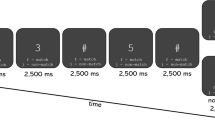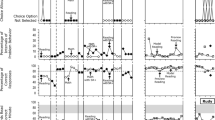Abstract
Underlying most research on biofeedback learning is a theoretical model of the processes involved. The current study tested a prediction from the Awareness Model: High initial EMG awareness should facilitate response control during EMG biofeedback training. Seventy-two undergraduates were assessed for forehead EMG awareness by asking them to produce target responses from 1.0 to 5.0 µV every 15 s for 16 trials. Based on this assessment, two groups (high and low awareness) were trained for 64 trials to produce these target levels with either EMG biofeedback, practice (no feedback), or noncontingent EMG feedback. A transfer task was identical to the initial assessment. During training, the biofeedback group deviated less from target than the practice and noncontingent groups. The biofeedback group was the only group to improve from initial EMG awareness activity. During transfer, only the low awareness biofeedback group remained below initial EMG awareness level. These findings can be interpreted in terms of the Two-Process Model.
Similar content being viewed by others
References
Alexander, A. B. (1975). An experimental test of assumptions relating to the use of electromyographic biofeedback as a general relaxation training technique.Psychophysiology, 12, 656–662.
Bayles, G. H., & Cleary, P. J. (1986). The role of awareness in the control of frontalis muscle activity.Biological Psychology, 22, 23–35.
Bilodeau, I. M. (1966). Information feedback. In E. A. Bilodeau (Ed.),Acquisition of skill. New York: Academic Press.
Brener, J. (1977). Sensory and perceptual determinants of voluntary visceral control. In G. E. Schwartz & J. Beatty (Eds.),Biofeedback theory and research (pp. 29–66). New York: Academic Press.
Budzynski, T. H., & Stoyva, S. M. (1969). An instrument for producing deep muscle relaxation by means of analog information feedback.Journal of Applied Behavior Analysis, 2, 231–237.
Davis, J. F. (1952).Manual of surface electromyography. Montreal: Laboratory for Psychological Studies, Allen Memorial Institute of Psychiatry.
Dunn, T. G., Gillig, S. E., Ponsor, S. E., Weil, N., & Utz, S. W. (1986). The learning process in biofeedback: Is it feedforward or feedback?Biofeedback and Self-Regulation, 11, 143–156.
Epstein, L. H. (1990). Perception of activity in thezygomaticus major andcorrugator supercilii muscle regions.Psychophysiology, 27, 68–72.
Fisher, L. E., & Kotses, H. (1974). Experimenter and subject sex effects in the skin conductance response.Psychophysiology, 11, 191–196.
Fridlund, A. J., & Cacioppo, J. T. (1986). Guidelines for human electromyographic research.Psychophysiology, 23, 567–589.
Glaros, A. G., & Hanson, K. (1990). EMG biofeedback and discriminative muscle control.Biofeedback and Self-Regulation, 15, 135–143.
Greenstadt, L., Shapiro, D., & Whitehead, R. (1986). Blood pressure discrimination.Psychophysiology, 23, 500–509.
Grigg, L., & Ashton, R. (1984). Heart rate discrimination and heart rate control: A test of Brener's theory.International Journal of Psychophysiology, 2, 185–201.
Harver, A., Katkin, E. S., & Bloch, E. (1993). Signal-detection outcomes on heartbeat and respiratory resistance detection tasks.Psychophysiology, 30, 223–230.
Kinsman, R. A., O'Banion, K., Robinson, S., & Staudenmayer, H. (1975). Continuous biofeedback and discrete posttrial verbal feedback in frontalis muscle relaxation training.Psychophysiology, 12, 30–35.
Kirk, R. E. (1982).Experimental design: Procedures for the behavioral sciences (2nd ed.). Belmont, CA: Brooks/Cole.
Kotses, H., & Segreto-Bures, J. (1983). Subject expectancy effects in frontal EMG conditioning.Biological Psychology, 17 97–104.
Lacroix, J. M. (1981). The acquisition of autonomic control through biofeedback: The case against an afferent process and a two-process alternative.Psychophysiology, 18, 573–587.
Lehrer, P. M., Batey, D. M., Woolfolk, R. L., Remde, A., & Garlick, T. (1988). The effect of repeated tense-release sequences on EMG and self-report of muscle tension: An evaluation of Jacobsonian and post-Jacobsonian assumptions about progressive relaxation.Psychophysiology, 25, 562–569.
Lisina, M. I. (1960). The role of orientation in the transformation of involuntary into voluntary reactions. In A V. Zaporozhets (Ed.),The development of voluntary movement. Moscow, USSR: RSFSR Academy Pedagogical Sciences.
Marinacci, A. A., & Horande, M. (1960). Electromyogram in neuromuscular re-education.Bulletin of the Los Angeles Neurological Society, 25, 50–71.
Miller, S., & Konorski, J. (1928). On a particular type of conditioned reflex.Proceedings of the Biological Society, 99 1155–1157.
Pollard, R. Q., Jr., & Katkin, E. S. (1984). Placebo effects in biofeedback and self-perception of muscle tension.Psychophysiology, 21 47–53.
Reed, S. D., Harver, A., & Katkin, E. S. (1990). Interoception. In J. T. Cacioppo & L. G. Tassinary (Eds.),Principles of psychophysiology: Physical, social, and inferential elements (pp. 253–291). Cambridge: Cambridge University Press.
Ring, C., & Brener, J. (1992). The temporal locations of heartbeat sensations.Psychophysiology, 29, 535–545.
Segreto-Bures, J., & Kotses, H. (1982). Experimenter expectancy effects in frontal EMG conditioning.Psychophysiology, 19, 467–471.
Segreto-Bures, J., & Kotses, H. (1984). Effects of noncontingent feedback on EMG training, EMG responses, and subjective experience.Biofeedback and Self-Regulation, 9 25–36.
Shearn, D. (1961). Does the heart learn?Psychological Bulletin, 58 452–458.
Shedivy, D. I., & Kleinman, K. M. (1977). Lack of correlation between frontalis EMG and either neck EMG or verbal ratings of tension.Psychophysiology, 14, 182–186.
Sherrington, C. (1948).The integrative action of the nervous system. New Haven: Yale University Press.
Sime, W. E., & DeGood, D. E. (1977). Effect of EMG biofeedback and progressive relaxation training on awareness of frontalis muscle tension.Psychophysiology, 14, 522–530.
Skinner, B. F. (1935). Two types of conditioned reflex and a pseudo type.Journal of General Psychology, 12, 66–77.
Skinner, B. F. (1938).The behavior of organisms. New York: Appleton-Century.
Staudenmayer, H., & Kinsman, R. A. (1976). Awareness during electromyographic biofeedback: Of signal or process?Biofeedback and Self-Regulation, 1, 191–199.
Stevens, S. S. (1956). The direct estimation of sensory magnitude-loudness.American Journal of Psychology, 69, 1–25.
Stilson, D. W., Matus, I., & Ball, G. (1980). Relaxation and subjective estimates of muscle tension: Implications for a central efferent theory of muscle control.Biofeedback and Self-Regulation, 5, 19–36.
Townsend, R. E., House, J. F., & Addario, D. (1975). A comparison of biofeedback-mediated relaxation and group therapy in the treatment of chronic anxiety.American Journal of Psychiatry, 132, 598–601.
Whitehead, W. E., & Drescher, J. M. (1980). Perception of gastric contractions and self-control of gastric motility.Psychophysiology, 17, 552–558.
Author information
Authors and Affiliations
Rights and permissions
About this article
Cite this article
Segreto, J. The role of EMG awareness in EMG biofeedback learning. Biofeedback and Self-Regulation 20, 155–167 (1995). https://doi.org/10.1007/BF01720971
Issue Date:
DOI: https://doi.org/10.1007/BF01720971




